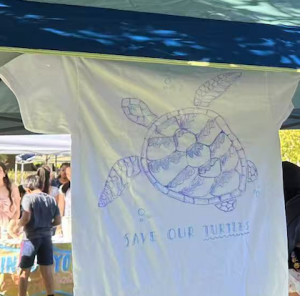By Ellie S. and Sanyukta R.
Introduction
On one Saturday morning in July, we decided to spend our summer break a little differently than most high schoolers would. Instead of driving out to the mall to hang out with friends, or getting ready to go tan at the beach, we attended the best combination of both worlds: the 2024 Global Green Development Summit, hosted by the Global Green Development Alliance (GLOGDA). .
Held on July 20th from 8:30am to 5:15pm at the Stanford Faculty Club, the summit was arranged to bring scientists, investors, and city council officials together in response to the pressing impacts of climate change. Officials including the Mayor of Saratoga, Mayor of Burlingame, and Mayor of San Mateo were all present and contributed consistently to the discussion. This year’s meeting gathered close to 200 attendees, the highest participation in the event thus far, and in celebration of GLOGDA’s fifth anniversary.
Key Speeches/Attendees
The conference kicked off with a small opening ceremony by honored guests and representatives from the hosting organizations. After a brief introduction, the co-hosts expressed their enthusiasm about the opportunity to host this event t. Xiaofeng Zhang, the organizer and president of GLOGDA, concluded the kick off with a warm welcome to all the attendees.
The morning consisted of several keynote speeches on the topic of “Energy Transition and Innovation for Carbon Neutrality” from important people with various backgrounds in research. Some spoke from the perspective of economics and policy, while others from the perspective of science and engineering.
Notably, a few well known scientists spoke.
Dr. Yi Cui, a renowned professor at Stanford, spoke about finding more resilient and convenient solutions to lithium batteries. He covered the various downsides to using lithium such as it being unable to sustain high or low temperatures. His lab’s research showed that magnesium oxide and other metals would be more suitable under those extreme conditions. Despite these new technologies being currently present in the space industry, to commercialize them for electric vehicles and to incorporate them into our daily lives would be a challenge.
Dr. Daniel Kammen, a Nobel Peace Prize winner and research scientist at Berkeley, also spoke about the more economic aspects related to climate technologies and their commercialization processes. His lab, Renewable and Appropriate Energy Laboratory (RAEL) investigates everything from the development of technology in both developing and industrialized countries to designing and testing energy systems.
Panels
This year’s summit held a wide variety of panels all aimed towards specific areas of climate tech and legislation. One notable panel was the Energy Transition and Innovation for Carbon Neutrality roundtable discussion, where key speakers, including Dr. Richard Dasher, the Director of US-Asia Technology Management Center at Stanford, Nan Zhou, a Senior Scientist at the Lawrence Berkeley National Laboratory, and Charlie Zai, Principal Program Manager at PG&E, among others, contributed substantially to the discussion.
Further, the Renewable Energy panel, led by Mr. George Zhou, Senior Vice President of GLOGDA, brought forth a lot of discussion about potential innovation and investment in small-scale climate tech. Specifically, Wendy Zhang, Director of ESS Business Development & Policy at CATL USA, dove deeper into her progress with the Central California Clean Energy Transmission Project, as well as her past progress at PG&E.
A specifically spirited panel was the Women in Green Development discussion, which was packed with powerful female leaders, from Dr. Jian Zhang, CEO of Chinese Hospital, to Donna Wills Colson, Mayor of the City of Burlingame as well as Yan Zhao, Mayor of the City Saratoga. The panel emphasized the importance of young people taking the initiative to increase female representation in all areas of green development, as well as cementing self-confidence when it comes to representation.
Overall, there was a grand total of nine panels which all gave the attendees more insight into some of the details within many fields of sustainable development.
Food
Food at Stanford never disappoints.
Upon arrival, guests were invited into the Redwood Room to help themselves to a meal of croissants, delicious muffins, and fresh fruit. Refreshing drinks such as iced tea and lemonade were offered. Those who needed an extra caffeinated boost to the day were also able to help themselves to coffee and hot tea. Two stations were set up for accessibility, one in the Redwood Room and another in the actual conference room.
After the morning of keynote speeches and a panel, attendees sat down to enjoy a well cooked meal. Following the scent of freshly sauteed vegetables and grilled salmon, guests were either led into the main conference room to sit down, or at a patio where circular tables covered with white table cloth were set up.
For lunch, guests ate a salad tossed with vinegar and olive oil and their choice from the array of dishes including baked potato and sauteed squash, as well as pork and salmon. For dessert, there were lots of options to choose from but the one that arguably tasted the best was the perfectly prepared tiramisu cake.
After lunch, drinks were always readily available, including soft drinks which made the experience of listening to different panels that much more enjoyable.
Overall Experience
The overall experience was great as we got to learn a lot from some very experienced people in the field. We were also not fully aware of all the specifics behind climate innovation in areas not limited to policy making, energy storage, and innovation scalability, so the summit gave us loads of information and educated us on how to reduce our individual carbon footprints.
In general, we would recommend the conference to people of all areas, from students to aged professors and investors. The Global Green Development Summit offers a chance to delve into the unique perspectives that are at the forefront of climate innovation.






